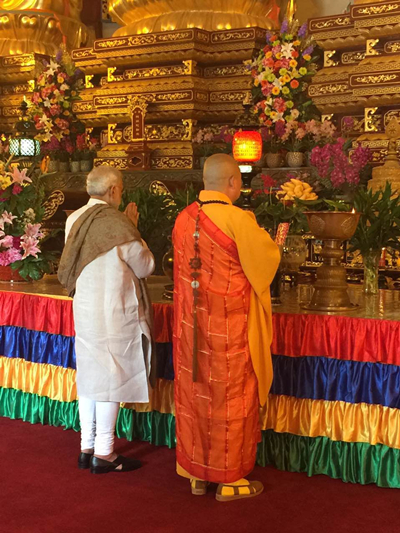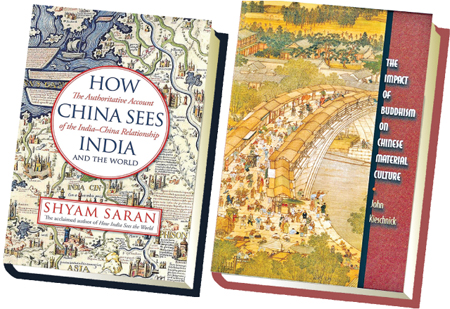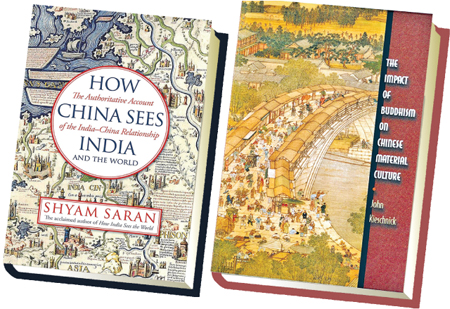By P.K.Balachandran/Sunday Observer
Colombo, January 14: Buddhism went to China from India in the first millennium after Christ. But over time, it took a Chinese form, which in turn, was transmitted to Korea and Japan, says Shyam Saran in his book How China sees India and the World (Juggernaut Books, New Delhi, 2022).
It was in the first century AD that Buddhism began to influence Chinese culture, bringing to it several new concepts, beliefs, practices and patterns of behaviour, Saran says.
John Kieschnick writes in his book Impact of Buddhism in Chinese Material Culture that Indian Buddhism introduced to China a new pantheon of deities, the practice of making offerings to sacred images, and also rituals of consecration. The belief in reincarnation, the doctrine of karma, seated meditation and greeting with the palms held together were among the new things introduced.
At that time, the Chinese looked upon India as a source of wisdom, thanks to the Chinese Buddhist monks who travelled in India and Indian monks who travelled to China. The visiting Indian monks translated Buddhist works from Pali to Chinese.
“Buddhist scriptures brought a new vocabulary, new expressions and metaphors which, over time, were embedded in Chinese colloquial language, literature and thought. China also adopted the relic culture associated with Buddhism and various Chinese ruling dynasties sought to acquire items associated with Lord Buddha, including ashes and pieces of bone left in his funeral pyre,” Saran says.
“There were Chinese rulers who, having heard of the legend of King Ashoka constructing 84,000 stupas across India to house Buddhist relics, sought to do the same in their own kingdom. The Tang diplomatic mission in King Harsha’s court in the seventh century went on a pilgrimage to Bodh Gaya and carried back a rubbing of the footprint of the Buddha engraved on stone. Saplings of the Bodhi tree were carried,” he adds.
However, such Indian inputs became a trickle in the Second Millennium as by that time, Buddhism had vanished in India due to the Muslims invasion of North India, the nerve centre of Indian Buddhism.
But this enabled China to develop its own brand of Buddhism from the 8th.Century onwards. “Buddhism with Chinese characteristics” influenced Buddhism in Korea, Vietnam, Tibet and Japan. Chinese, rather than Indian monks, carried Buddhism to these areas in China’s periphery.
Sacred Mountains
China also created four sacred mountains for its brand of Buddhism These were: Mount Emei in Sichuan (South West China where Chengdu is); Mount Putuo in Zhejiang (in East China facing the East China Sea); Mount Jiuhua in Anhui (in South East China) and Mount Wutaishan in Shanxi (in North China).
There were sacred centres in China dedicated to Manjusri, the Bodhisattva of Supreme Buddhism. Manjusri, in Mahayana Buddhism, is a Bodhisattva (a Buddha to be) personifying supreme wisdom. His name in Sanskrit means “gentle, or sweet, glory”. In China he is called Wen-shu Shih-li. The sacred sites associated with Manjusri attracted pilgrims from India and other countries also.

The “Sinisisation” of Sinification of Buddhism resulted in the emergence of Chinese Buddhist schools of thought such as Tiantai (Celestial Platform), the Huayan (Flower Garland), the Qing tu (Pure Land) and Chan (Zen in the Japanese version).
Each of these schools was based on a particular Buddhist scripture and developed its own modes of transmission through particular patriarchs. The originator of the line of patriarchs in some cases could even be the Buddha.
The Tentai school is based on the Lotus Surtra (Saddharma pundarika sutra), which teaches that everybody can attain Buddhahood, just as they are, in this lifetime. A person only needs to follow the Bodhisattva path—taking compassionate action for others, based on the recognition that true happiness for oneself is impossible while others suffer.
The Qing tu (Pure Land doctrine) is the basis for the cult of Buddha Amitabha who dwells in the Western Paradise of Sukhavati. The chanting of the name of Amitabha (A-mi-to-fu in Chinese) ensures entry into Sukhavati, where there is no pain or sorrow. The foundational texts of the Pure Land doctrine are the Amitayus-Vipasyaa-Sutra (Discourse Concerning Meditation on Amitayus).
The Amitayus sutra presents 16 forms of meditation as means of reaching the Pure Land and concludes that even the most wicked can attain this paradise by invoking the name of Amitayus.
The Huayan schools draws inspiration from the Avatamsaka Sutra which is based on the idea of all beings being essentially equal. The Huayan school drew inspiration from the Madhyamika (Middle Way) teachings of the second century AD Indian philosopher Nagarjuna.
The Chan school had the greatest influence in China, with its Japanese version, Zen, becoming very popular. Chan is the Chinese version of the Sanskrit Dhyana (contemplation). Dhyana is a combination of Dhi (mind) and Yana (movement). Dhyana, Chan or Zen owes its origin to Indian philosopher Patanjali’s work “Yoga Shastra” composed in the first or the second century BC.
Chan was taken to China by the Indian monk Bodhidhrma in the sixth century AD. According to Chinese sources, Bodhidharma was the son of a Pallava king who ruled from Kanchipuram in Tamil Nadu. It was not difficult for Bodhidharma to teach Dhayna in China because the Chinese were already familiar with the doctrine of Tao (The Way) associated with the philosopher Zhuang Zi.
The concept of Dhayna/Chan/Zen stresses the importance of seeking truth from within oneself. As it travelled from India to China and thence to Japan, it acquired local colour and sensibility. The philosophy of Chan is reflected in the impressionist art of China and Japan as opposed to the faithful and meticulous representation of objects in Western art.
China also developed its own cults associated with Buddhist deities. The Bodhisattva Amitabha was a very popular cult. Chanting his name would bring relief from the pains and sufferings of the world, it was believed.
Then there was the cult of the Goddess Guanyin, based on love and provision of assistance to others to overcome life’s crises. Guanyin is the female form of the Avalokiteswara, the Bodhisattva of Compassion. Guanyin means “One who hears or listens.”
Avalokiteswara was regarded as the earthly manifestation of the Amitabha Buddha, who is deemed to be self-born and eternal. Amitabha Buddha was reputed to be able to take any form to come to the aid of the suffering on earth.

Buddhism in modern China
Following the collapse of the Qing dynasty, the last Chinese dynasty, in 1911, the anti-traditionalism of the then Chinese intellectual elite was embraced by the iconoclastic Chinese nationalists, says a publication of Columbia University on Buddhism in modern China.
This led to the widespread destruction of religious and ancestral temples in the 1920s. The “New Culture Movement” focused on changing traditional structures and beliefs that were believed to be preventing China from dealing with the onslaught of the West on China’s soil.
When the Communists came to power in 1949, they combined the anti-traditionalism already developed among the Chinese intellectual elite with Marxist-inspired contempt for all religious beliefs.
The destruction of ancestral temples, village temples, city god temples and every other vestige of traditional practice was carried out with even greater enthusiasm and more thoroughness by the Communists after 1949, compared to what had been attempted by the Nationalists in the 1920s and early 1930s.
However, since the establishment of the People’s Republic in 1949, freedom of religion, as well as freedom to propagate atheism, has been guaranteed in the Chinese Constitution. The government now grants official recognition as religious groups.
However, under the Communists, the number of believers affiliated publicly with the institutional religions had decreased significantly. But in the more permissive atmosphere of recent times, especially since the several national religious associations were reactivated in 1979, Buddhism and both denominations of Christianity have undergone a major revival, the Columbia university note says.
Religious practices are carried out within the family. And of late, China has been using its Buddhist past to forge fraternal ties with Buddhist countries like Sri Lanka, assisting monasteries with grants, and organising international Buddhist conferences.
END
The post Buddhism with Chinese characteristics appeared first on NewsIn.Asia.




